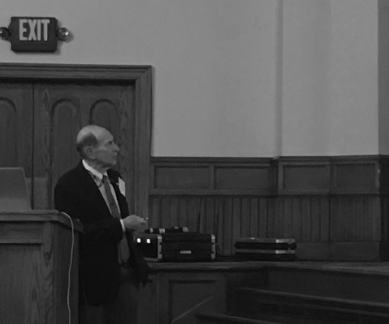28th Annual Lord Lecture shows promise of hydrogen power

University of Rochester Professor Richard Eisenberg discusses a carbon-free future during his lecture on Monday, Sept. 23, 2019, in Ford Memorial Chapel.
The Department of Chemistry hosted its 28th Lord Lecture, an annual event that brings leading scientists to campus to engage scholars of science throughout the Erie area.
Distinguished 2019 Lord Lecturer Richard Eisenberg of the University of Rochester gave a lecture titled “A Promise and Challenge for a Carbon-Free Energy Future: Artificial Photosynthesis and Solar Generation of Hydrogen,” at 7 p.m. Monday, Sept. 23, in Ford Memorial Chapel.
Eisenberg served as the editor-in-chief of the journal “Inorganic Chemistry” for 12 years. In 2003, Eisenberg won the American Chemical Society Award for Distinguished Service in the Advancement of Inorganic Chemistry. He was also awarded the 2005 Lifetime Achievement Award in Graduate Education at the University of Rochester. In 2010, Eisenberg was selected to be a U.S. National Academy of Science member.
“I usually don’t use a title that’s three lines long,” Eisenberg joked at the beginning of his lecture. “That is a long and impressive title. But, this is a big problem, and it’s a problem that all of us must face.”
That problem, Eisenberg said, is climate change. According to Eisenberg, humanity will need a 45% increase in energy production in 25 years if our current lifestyle continues. Eisenberg highlighted that 80% of the world’s energy comes from fossil fuels, and based on trajectories, a majority of energy will still come from carbon dioxide-emitting sources over the next 20 years.
“This means an increase in average global temperature,” Eisenberg said. “There’s a greater cycling of water between liquid and vapor state. Water, being a high atomic molecule, also has a greenhouse gas effect. The water molecule is doing a simple bending in the same way that carbon dioxide would.”
Eisenberg added that climate change will cause rising sea levels, increasing frequency of severe weather patterns, and most importantly, unpredictable consequences.
“No matter how smart you are, you may not be able to get all of those unpredictable consequences laid out,” Eisenberg said.
Eisenberg spoke about the potential for hydrogen as a fuel source. As an atom, hydrogen has a higher specific heat compared to coal, natural gas and ethanol and emits only water. Despite this, it is not a naturally available element; therefore, energy is required to make hydrogen.
“I’m a big proponent of hydrogen,” Eisenberg said.
Much of Eisenberg’s research over the past decade has dealt with proton reduction to hydrogen. In other words, artificial photosynthesis by splitting water into its separate elements: oxygen and hydrogen. A light absorber, a catalyst and a source of electrons is needed to do this, Eisenberg said.
“We took (the inorganic compound) CdSe (as a light absorber) … and a catalyst, (the organic compound) DHLA, … and ascorbic acid (as a source of electrons),” Eisenberg said. “What we found was, when we turned on the radiation, we got a lot of hydrogen. The turnover was up over a million. This worked very well.”
Eisenberg’s research is promising for American innovation in the field of alternative energy sources as Germany launched a hydrogen-powered train last year and Japan is hoping to have 40,000 hydrogen fuel cell cars on the road by next year.
“The bottom line is, this is our challenge,” Eisenberg said. “This is a challenge that should be put forward to all of us as scientists.”

Ethan Woodfill is a senior from Pittsburgh, Pennsylvania. He is an Environmental Science & Sustainability and Political Science double major with an...







